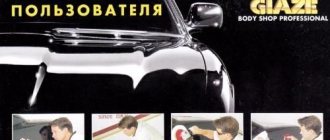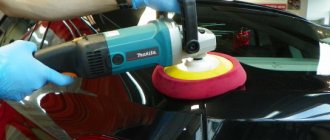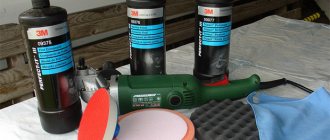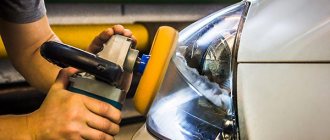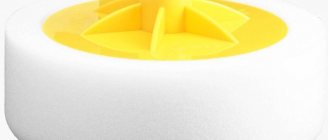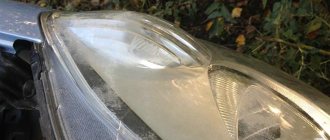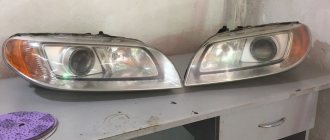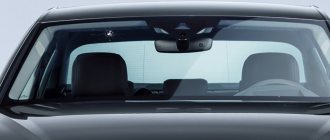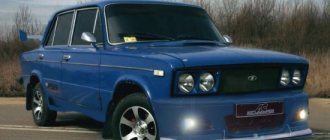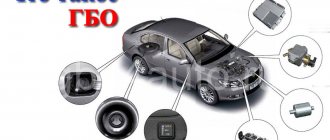What you need to polish your cars yourself
Let's look at what exactly you will need if you decide to polish the headlights, body and other parts of the car yourself.
- First of all, a sanding machine. Of course, if you don’t have it, you can do the job manually. However, this is only possible if we are talking about some areas or parts made of plastic. For complete processing of the car body, as well as for glass headlights, you will definitely need power tools. Manual work will not ensure the proper efficiency of the process.
List of necessary tools for polishing a car
If you don't have a sander, you can easily try replacing it with an electric drill. With the help of special accessories, an electric drill can easily be converted into a tool for grinding and polishing work.
- Adapter. Helps prepare a sander or electric drill for operations with certain attachments.
- Backing – designed to mount grinding and polishing wheels on the tool. Experts recommend using the Velcro option for processing cars at home.
- Grinding wheels. They differ in hardness and grain size of the abrasive. Depending on this, they are marked with different colors. There are the coarsest white circles - they have the maximum grain size and hardness. Used for initial surface treatment in case of deep damage. Black circles - for soft processing with non-abrasive products. Orange circles are universal for all types of work.
- Applicators. They are used to cover the surface of the car body with wax and polishes. Instead, you can use flannel or felt pieces of material.
Applicator for applying wax and polish
This is interesting: We independently change the oil pump on a VAZ 2114 and VAZ 2115
Polishing tools: what will you need?
Conventionally, there are two types of polishing tools: manual and electric. Electric is, of course, a grinding machine. It will need:
- Polishing wheels made of foam rubber of varying degrees of hardness. They are used both for working with abrasive pastes and with “closers”. Most specialists prefer foam rubber wheels for initial treatment, especially if deep scratches need to be removed.
- Special foam rubber circles with large relief for non-abrasive pastes.
- Wool circles. There are circles made of both natural and artificial wool. Due to the special structure of the fibers, the circle provides effective and quick shine.
Hand tools are also widely used, among which are:
- Skins with different grain sizes: from “null” to larger ones.
- Microfiber fabric with various properties.
- Polishing cloths (for finishing)
What else can you polish?
In addition to professional electric tools, hand-held car polishing tools and improvised means are used for do-it-yourself polishing. Hand tools include a plane and sandpaper. This method is used when it is necessary to perform high-precision work on small surfaces. These products are more often used at home, in the absence of a delta grinding device.
Handy tools are multi-purpose tools that can be used, among other things, for grinding metal surfaces. These include:
- drill;
- Bulgarian.
The devices perform the same functions as professional machines, but with less efficiency, so they are used exclusively at home in the absence of specialized tools.
Plane
Specialized hand tools for processing wood and steel surfaces. A plane is used for polishing a car when high-precision processing is required. Fine-grained sandpaper is attached to the tool, after which the specialist makes smooth translational movements along the surface. This treatment removes unevenness but causes minimal damage to the metal. The quality of the operation depends on the number of grinding directions: a variety of motion trajectories makes the surface smoother.
Bulgarian
The tool is an analogue of a disc grinder at home. Car enthusiasts come to polishing with an angle grinder after their car has received minor defects on the body. Compared to a professional machine, an angle grinder has a smaller circle radius and, as a result, less efficiency, but it copes well with small defects.
To eliminate minor defects, a foam rubber or wool disc and paste for application to the instrument are sufficient. It is important to use an angle grinder with adjustable speeds and modes, as well as an electronic system for maintaining speed under load in order to avoid causing even greater damage to the car.
Drill
Polishing a car with a drill is another budget-friendly way to polish a car body at home. A drill differs from an angle grinder in less power and speed, but at the same time it is lighter, more convenient to use and allows you to reach hard-to-reach places. Therefore, a drill is better suited for eliminating small defects in paintwork, while a grinder is preferable to use for smoother surfaces.
To use grinding wheels on a drill, you will need a special adapter.
Car polishing products
Automotive chemicals for polishing cars are now presented in such incredible quantities that even Mendeleev would get confused in them. It is impossible to list all car polishing products and their famous manufacturers in a separate article. Therefore, we will limit ourselves to only conceptual substances for self-polishing.
- Polishes without an abrasive composition for protective polishing of the body, available in paste, liquid and aerosol versions. The choice of polish depends on the type of surface - horizontal or vertical, and the degree of cloudiness of the paintwork. A not entirely positive characteristic of aerosol polishes is their small amount in the can. Polishes are essentially designed to give a car a fresh look, but not to eliminate defects.
- Polishing pastes, which are classified into micro, fine, medium, and coarse abrasive. Depending on the condition of the paintwork, polishing pastes are used and used. For example, to eliminate large defects in the form of drips, shagreen, scratches, coarse abrasive pastes are used.
By choosing the listed tools for car polishing, as well as, after consultation with a specialist, car polishing products, you will be able to independently maintain the attractive appearance of your car and the protective properties of the paintwork for a long time. We’ll look at the technology for polishing a car with our own hands in the next topic.
Home →
Maintenance and Repair →
Body work →
Types of polishing
The variety of materials, devices and means for polishing a car provides wide possibilities for using various methods and types of body treatment. Even one type of work is performed differently by craftsmen.
We use systems selected from personal experience and from different manufacturers. Among the many options, two main types of polishing stand out:
- paint restoration methods;
- providing protection from harmful influences.
Protective
Protective polishing is required for any car, even a new one, to protect the paint surface from the chemical effects of detergents, as well as the external environment. No grinding is used for this process.
If the surface of the body is not worn, it is enough to apply wax, Teflon or polymer protection, which is absorbed into the varnish coating and preserves it for up to a year. When the original color has faded, but there are no special defects, then the surface is first polished, without abrasive intervention.
Protective polishing steps:
- thorough cleaning and washing from dirt;
- degreasing the surface;
- polishing (without abrasive);
- applying a protective layer.
Work technique
Before you start polishing your car, you need to decide on the place and time. For a small area it will take 2-3 hours, and after that the car should stand for about an hour. The procedure is not recommended to be performed in direct sunlight or in a very hot room.
Before polishing a car with your own hands, you should prepare: thoroughly clean the polished area from dust, lime and insects. In addition to cleaning, it is recommended to degrease the car coating. For this it is best to use specialized tools.
After the preparatory stage, you can proceed to the main stage. Sanding the machine before applying paint is carried out in 2 stages:
- abrasive;
- polishing.
Protective polishing eliminates the first step.
The abrasive stage is the removal of large paint defects, requiring the application of a new layer of paint or varnish. In this case, the hardest attachment is inserted into the car body sanding machine, and the procedure is carried out with a large number of special consumables.
The protective stage is carried out after the abrasive stage and involves carefully applying a small amount of polishing mixture using soft nozzles.
Polishing the car is not done all at once, but in small areas. This is necessary so that the polishing mixtures do not harden prematurely and lie evenly on the body, providing shine. This approach also eliminates overheating of the polishing machine.
In order to properly polish a car at home, you need to understand the mixture, nozzles and pressure on the tool. Before starting, you should practice on unnecessary or rough parts so as not to damage expensive body parts.
Types of grinding machines
Now let's look at which power tools are suitable for polishing cars. In fact, it makes no difference what you use it for: for a car body or headlights - the same electric tool is used. The only difference will be in the type of abrasive and the number of revolutions.
When processing plastic or glass car headlights with your own hands, you must ensure that there is no overheating. Otherwise, a crack may form or the structure of the material may be damaged. Then all your further work will make no sense.
Polishing the hood with an orbital sander
To polish cars, you can use the following models of sanding machines:
- belt - the abrasive belt is tucked in and moves in a circle. This type of equipment has very high productivity. The design has a dust collector. This model is used for large areas, for example, for a car body;
- vibration - an abrasive element is attached to a flat platform, and grinding is performed with reciprocating movements with an amplitude of about 2 mm;
- orbital (or eccentric) - the abrasive wheel rotates around its axis and moves in a circle. Such equipment provides very high quality of the processed surface of the car body;
- grinder - in our country it is better known as a tool for cutting work. In fact, this is one of the types of grinding machines. In an angle grinder, the spindle is located perpendicular to the handle, which makes it very convenient to use. Suitable for both bodywork and headlights;
- straight - the same as the grinder, but the spindle is located at the end of the handle;
- brush - performs its function using a system of hard brushes.
The number of revolutions for grinding machines is recommended in the range from 1000 to 3000 revolutions. There are models with a battery, but you shouldn’t choose them - the charge will last no more than 10 minutes. The grinder is considered the most versatile and convenient option - it is used by the vast majority of car owners.
This is interesting: What to do when the emergency oil pressure lamp on a VAZ 2110 is on
How to choose a car polishing machine
When choosing a polishing machine for work, it is necessary to take into account the power and operating principle of the device, the number of straight surfaces and seams, hard-to-reach places on the car, the type and thickness of the paint layer, the number, depth and density of small defects on it.
By type, polishing machines are divided into:
- tape;
- vibration;
- delta grinding;
- orbital (eccentric);
- corner (disc).
Each model has its own features and advantages.
Disc machines
In appearance and operating principle, the device resembles a grinder. A disc-type car sander is an inexpensive and highly effective tool. The type of spindle rotation allows you to work at large angles, but requires caution. It is not recommended to use such a machine for a thin layer of paint. Professional disc grinders differ from angle grinders in diameter: for “home” work on a personal car or a small metal surface, an angle grinder with a radius of 125 is suitable. A device with a radius of 185-205 is used professionally.
Among the domestic manufacturers of sanding machines, the Interskol company should be highlighted. Its tools are great for performing tasks of medium complexity, so they are often used by car mechanics for polishing cars.
Orbital cars
The tool is made more complex than disk devices. The cost of an orbital polisher for a car of the same power is higher than for a disc polisher.
The device consists of a sole to which a disc is attached. During operation, in addition to the rotation of the disk, a translational movement is performed, moving it along the sole.
The orbital machine is in great demand and is considered a better tool among professionals than other types of polishing devices. Due to translational movements, the speed of work and the area of the simultaneously processed surface increase. In addition, the device causes less heating of the surface, so when working with an eccentric machine, the paint does not fade and is better preserved. It is more expensive than other devices, but professionals recommend this type of tool.
Tape
Performs grinding due to the movement of a looped abrasive belt. Used for removing paint from large flat surfaces. The use of such a device is justified, but it will require additional equipment for the operator to access hard-to-reach areas. Used for rough processing before painting.
Vibratory and delta grinding
The machine has a sole with an abrasive coating. Provides accurate and high-quality processing of small surfaces. Vibrating car body polishers are quite heavy and are not suitable for large surfaces, but work well on uneven surfaces.
Delta grinding devices operate on the same principle as abrasive ones, but their sole is shaped like a triangle. This further reduces the area and speed of work, but allows you to reach the most difficult to reach places. Professionals use this type of tool to sand seams, defective surfaces and other natural and acquired irregularities.
Necessary equipment
To polish a car body with your own hands, you only need one tool - a grinding (polishing) machine.
An analogue can be a hand-held electric drill, only for it you need to purchase a special attachment and so-called “Velcro” for attaching polishing wheels. And in addition to the tool, we will need a whole set of important accessories. When choosing a polishing machine, give preference to models that can spin the disc up to 1000 - 3000 rpm and have the ability to work from the mains, since the battery will last for 15 minutes of continuous operation. Also pay attention to the presence of a power compensator. This makes it possible for the machine to operate at the set speed under load, when the polishing wheel is pressed against the car body, without losing power.
To operate the polishing machine you will need:
We will also include a device for applying protective polishes (liquid glass, wax) to the list of equipment for polishing a car body. At home, simple foam rubber is suitable for us. And for polishing the applied polish, we will use a soft, lint-free cloth. The protective polish in paste form can be polished with a polishing machine.
If you have to carry out deep polishing, then you will need sanding paper P 2000 - 2500. When sanding, the sandpaper must be constantly moistened with water.
Entrust polishing to professionals!
Many car owners have faced the sad consequences of self-polishing. However, many damages can only be solved by painting the body. Therefore, wanting to save a few hundred rubles on polishing, drivers lose tens of thousands.
On your own, we recommend polishing only with non-abrasive pastes and hand tools. Where abrasives and electric machines are used, you should entrust the work to professionals in Moscow. You will save time, effort, and money.
You can entrust professional polishing of your car body to our specialists! Just call us by phone: +7 (495) 150-50-20
Publication date:
May 24, 2016
Tools and Supplies
The following tools and consumables are used for grinding to metal:
- grinding machine with attachments for metal;
- brushes for metal of varying hardness;
- special holder for sandpaper;
- coarse sandpaper.
For grinding to metal, a household grinder or an angle grinder is usually used as a machine.
At the same time, for the process of removing paint and varnish to metal, its main parameter when choosing is power. The greater the power and spindle speed, the faster and more efficient the procedure for removing paint and stripping down to bare metal will be.
For polishing, the requirements for the tool are somewhat different, since this procedure requires special care and precision. Depending on the type of polishing, which will be discussed below, the following tools and consumables are used:
- grinding machine (more about their varieties below);
- attachments for securing polishing wheels;
- polishing wheels made of foam rubber or other material;
- polishing liquids or pastes (depending on the type of polishing and its purpose).
Since polishing a car body is a process somewhat more varied and complex than simply removing paint, the approach to choosing a tool is slightly different.
We select a tool for polishing a car body with our own hands
The appearance of your four-wheeled friend primarily depends on the condition of the body paint, which, as a result of exposure to external factors, can acquire defects such as scratches, abrasions, chips, etc. It is to eliminate the above defects that polishing is used. However, anyone who decides to carry out this operation on their own needs to know that this process is quite labor-intensive and requires not only theoretical, but also practical skills.
List of tools and components for polishing
A car body polishing tool is a fairly simple and inexpensive set of tools and materials that can be purchased at almost any hardware store. That is why many decide to purchase and further use everything they need for its intended purpose.
So, to implement our plan we will need the following:
- Car polishing machine. This specialized device is the most convenient and practical for work, but in order to save money, the availability of additional devices, as well as small amounts of work, it can be replaced with an ordinary drill.
- An adapter for a drill is a specialized device onto which a polishing wheel or attachment is safely and securely attached, if the choice nevertheless fell on the above tool.
- Wheels and attachments for car polishing.
- Adapters used when it is necessary to replace a wheel or attachment on a disk.
- Applicator for uniform application of polish, wax or abrasive.
If you have acquired practical skills and decided to make money by polishing cars, then you definitely need to have a grinder in your arsenal of tools, which is ahead of a drill in many respects (ergonomics, power, safety in operation).
Practice shows that it is best to purchase tools for polishing a car body in specialized stores, where you can get professional advice on application. Also, when purchasing, you need to pay attention to the presence of instructions included with high-quality equipment and devices, which describe in detail the procedure and scope of application, which will help you save nerves and money.
Choosing a car polishing machine
Choosing the right car body polishing machine will help greatly simplify the work process, as well as save money when purchasing.
Related article: Damage to a plastic bumper - what is needed for repair?
Main technical characteristics of the grinder:
- Power. This parameter is the starting point when choosing equipment. The more powerful the machine, and the average power is 1200 - 1400 W, the more universal its use will be.
— The ability to adjust the disk rotation speed is a very important function, which is necessary at different stages of work, and is also indispensable when polishing surfaces made of various materials.
— Power compensation. This function is implemented by the presence of a compensator in the machine, which maintains the same number of revolutions when the load level changes. It is not so much dangerous to reduce the number of revolutions when pressing hard on the machine, but to sharply increase them when releasing them, which can cause overheating of the temperature-sensitive varnish or the polish itself.
— The soft start function of the engine allows for protection against significant starting currents, the occurrence of which affects the longevity of the equipment. Thanks to this feature, you can turn on the machine, already leaning it against the surface to be treated, without fear of scorch formation due to a sharp increase in speed.
- Weight. The optimal weight of the machine, in order to avoid discomfort during operation, should be no more than 3 kg.
— Possibility of autonomous operation. In principle, the function is of little use and expensive due to the short operating time of the device on battery power.
— Size and ergonomics. The minimal dimensions of the device will help to carry out polishing in less accessible places, and how well the tool fits in the hand will affect the comfort and productivity of work.
Wheels and attachments for car polishing
In any store or market, the range of these devices is presented very widely, but when choosing, you need to take into account the following nuances:
- the purchase should be made taking into account the specifics of the abrasive used and the desired surface roughness of the material being processed;
- design differences depending on the equipment used (grinder or drill);
- Poor quality body polishing equipment, or equipment not technically designed for this type of work, can lead to significant damage, which will only aggravate the problem.
Stiffness is the main difference between the circles. The harder the wheel, the coarser the polishing paste can be used together. Polishing wheels can be of the following types:
- Solid. Used to remove dust, scratches or shagreen.
- Medium and soft. Used to add shine and gloss to the surface.
- With a relief surface. Used for large volumes of work to enhance shine.
Related article: ColorTech paint drying booths. Overview of installations, as well as a description of the main advantages.
When buying wheels in a store, you can also distinguish them by color: white is the hardest and is used together with a coarse polish, orange is softer and is considered universal, black is used exclusively with a protective (non-abrasive) polish.
However, you need to understand that, ideally, it is necessary to use wheels of varying hardness in stages - from a harder one at an early stage to a softer one at the final stage.
Currently, the most popular are circles made from the following materials:
- wool. The circle can be made entirely of wool, or with the addition of various synthetic materials. Wool can also be simply pressed or woven. The latter option is used when a quick and effective polishing result is needed;
- foam rubber As a rule, this material is used without additional impurities. The main difference between circles made of foam rubber is the size of the cells. The smaller the cell, the softer the polishing effect.
Abrasives
Before choosing the means by which polishing will be carried out, you need to know that the process itself can be of two types:
1. Protective polishing – serves to prevent and maintain the paintwork in its original form. With this type of paint coating treatment, it is enough to use a special non-abrasive polish, which will visually refresh the color and smooth out any microcracks that have formed.
Polishes can be of several types depending on the base: wax, Teflon or other types.
2. Restorative polishing – designed to eliminate defects caused by external factors. Such defects include chips, matte coating and small cracks. For this type of work, various abrasive polishes are used, in conjunction with materials used in finishing the surface.
Using a special polish as an abrasive implies following a step-by-step technology for performing the work:
- Removing the oxide layer of the paint coating or defect using an abrasive polish or sandpaper (P1000 - P5000 depending on the depth of the defect). Often, when there is significant damage to the paint, to save time, the use of sandpaper is inevitable. The abrasive polishes themselves can be: fine, medium and coarse.
- The use of non-abrasive (protective) polishes to bring the surface to the desired result.
Abrasive Techniques
To vary the abrasive force (cutting ability of the abrasive paste), three polishing techniques are used. This is varying the speed of rotation of the polishing wheel, the pressure on the wheel, and the speed of movement of the machine. Let's take a closer look at how these techniques can be used.
Polishing wheel rotation speed
The spindle of a rotary polisher rotates on only one axis, like a drill. Typically from 600 to 3000 rpm. You can use the RPM range from 600 to 1500 when polishing almost any car. Work at lower speeds and increase them gradually.
When using wool wheels, the greatest impact occurs at 2000-2500 RPM. After this, you can complete the work at 1100–1300 rpm with foam circles. You can polish less aggressively with wool wheels at speeds of 1600–1800.
The required rotation speed depends on many variables, such as the hardness of the paint, the technique used, and the hardness of the wheel. If the paint is hard, the rotation can be quite fast, while with a soft paint finish, the paint may overheat at the same settings.
- The rotation speed of the wheel affects the cutting ability of the paste. The faster, the greater the abrasive effect; the slower, the softer the paste acts.
- The slower the rotation, the less defects are eliminated, but it is easier to control the machine. Low speed heats the paint less.
- The faster the rotation, the better the defects are eliminated, but the more the paint heats up. It also produces more small circular scratches.
- It is not recommended to exceed 1800–2000 rpm.
Circle pressure
- The abrasive effect can be varied by increasing the pressure of the polishing wheel on the surface of the paintwork. In this case, too much pressure will not allow the abrasive paste to work correctly. The pressure on the circle should not be strong. Most often, the weight of the polishing machine itself is enough.
- It is sometimes necessary to apply pressure on the wheel during polishing in order to enhance the effect in certain places where a scratch or dullness is not removed by the usual action of the wheel. As mentioned earlier, you can tilt the circle slightly to one side to concentrate the action in one place. The rest of the time, the pressure on the circle should be minimal.
- To reduce the abrasive effect, you can slightly lift the machine. Thus, the pressure of the polishing wheel on the paintwork becomes less.
Machine speed
The rotary machine must be constantly moved while polishing so that the heat does not concentrate in one place. The paint can overheat in seconds and wear through the varnish. Polishing should be done with slow, even movements.
The direction of movement of the wheel during polishing. Each pass should overlap the previous one by 50%.
- The slower the machine moves over the surface, the more defects are eliminated. If the wheel rotates too quickly and the machine moves too slowly, the risk of paint overheating and damage increases.
- When the machine moves quickly, fewer defects are removed. If you move the machine too quickly, the abrasive paste will not have time to act on the paintwork. Scratches and dullness will remain.
- Rapid movements of the machine often involve changing the inclination of the wheel and polishing with the edge, which leads to the appearance of holograms, but it seems that the polisher is working quickly and efficiently.
- You need to learn to feel the required speed of the machine when you start practicing.
Polishing wheels
Different manufacturers have different quality and hardness of polishing pads, but the range of colors is the same. As a rule, the foam rubber and paste are of the same brand. This is an optional condition. You can take sponges that you like best and that suit you in size and price.
READ Features of polishing a black car
What does the color of the polishing pad mean:
- White (or wool) is the hardest, used for deep cutting if the body has significant defects and scratches.
- Green is used as a finish after white with paste (74).
- Yellow and orange (medium hardness) have a slight difference, so they are interchangeable. Sanding often starts with them.
- Blue (soft) is used after orange (75). This is a finishing touch after the previous polishing pad.
- Black is the softest for non-abrasives (76) and polishes.
If you select a sponge for your base, it should be 10 mm smaller or come with foam rubber. You can take both single-sided and double-sided.
It is more convenient to use double-sided jaws that have an adapter in the center for attachment to the spindle.
It is usually recommended to wash the circles in a soapy solution and then dry them or work with a damp sponge. This is acceptable when the foam is soft with low density. Hard circles lose their original qualities and become softer, so we recommend cleaning them with a brush.

